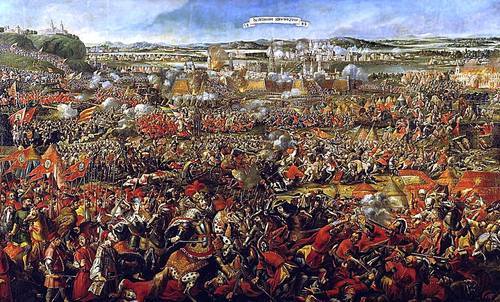

Attila invaded France, at that time called Gaul, in one of a series of conflicts with Rome. The location of the battle is not known with certainty, but is somewhere in modern France. In this battle, the Romans fought the Hunnic Empire under Attila with the help of barbarian allies, called Foederati. Although I do not know of any instances in which Tolkien himself confirmed this, he was likely familiar with this battle because of its importance to Roman history. The Battle of Pelennor Fields bears many strong resemblances to the Battle of the Catalaunian Plains. It also discusses (on pages 4-6) similarities between Tolkien's fiction and the Beowulf epic (of which Tolkien published a translation). The Tolkien Society has a document Angle-Saxon - Part Two that discusses (on pages 8 and 9) similarities between Tolkien's battles and the Battle of Malden. Tolkien "read the proofs", made "corrections and contributions", and offered solutions "to many textual and philological problems". The Battle of Maldon is an edition of the Old English poem The Battle of Maldon. Tolkien studied the poem enough to be credited as assisting with the publication of a modern translation. One possible source is the poem referred to as The Battle of Malden which described the defeat of a Saxon army by Viking invaders.

It is reasonable to believe that he drew from these accounts when describing battles in The Lord of the Rings. Tolkien had experience of the horrors of 20th century warfare, which may well have influenced his description of Saruman's strategies.īut for the most part, the great battles in The Lord of the Rings (Helm's Deep, Pelennor Fields, The Black Gate) seem to recall a simpler age when there was, at least occasionally, an opportunity for individual heroism to affect the outcome.Īs a professor of Anglo-Saxon, Tolkien studied and translated many old English texts that described battles in the first millennium, so he would have been familiar with how they were described. I read through both accounts and they strike me as very similar.Īs noted in the comments on the question. But I encourage you to have a look at the Battle and determine whether or not you think there is any merit to the suggestion. I am not a very articulate individual, so my case may not be very convincing. But I think it is easy to see how the battle of Vienna, it's importance to the Europe, and conclusion in a massive cavalry charge, could have inspired Tolkien's Battle of Pelennor Fields These battles are hardly mirrors of one another, there are obvious differences. Incidentally his charge also has the honor of being the largest cavalry charge ever recorded. His charge routed the Turkish Army, and relieved the city. Finally Sobieski emerged with a force of Cavalry numbering ~18,000 strong, with the Polish Hussars forming the vanguard. Though the infantry were very effective, they were quickly becoming exhausted. The Cavalry maneuvered into a better position to attack the greater Turkish force. When the relief force finally arrived, the German and Polish infantry set to work attacking the opposing force, which they did with great effectiveness. A relief force was also underway from the Holy Roman Empire. Although that was also in response to an existing treaty. However, a call for aid was sent out, and King Sobieski of Poland answered.

The Attacking force was far greater and the defending garrison woefully undermanned. The European leaders recognized that if it were to fall, the Turkish army could advance deeper into the continent. The most notable being the similarities between the Battle of Pelennor Fields and the Siege of Vienna 1683.Īt the time Vienna was viewed as the gateway to Europe, so when the Turks invaded, it was an essential objective. I don't think many can really say for certain what inspired the great battles of LOTR, but there are at least a number of parallels with real events.


 0 kommentar(er)
0 kommentar(er)
